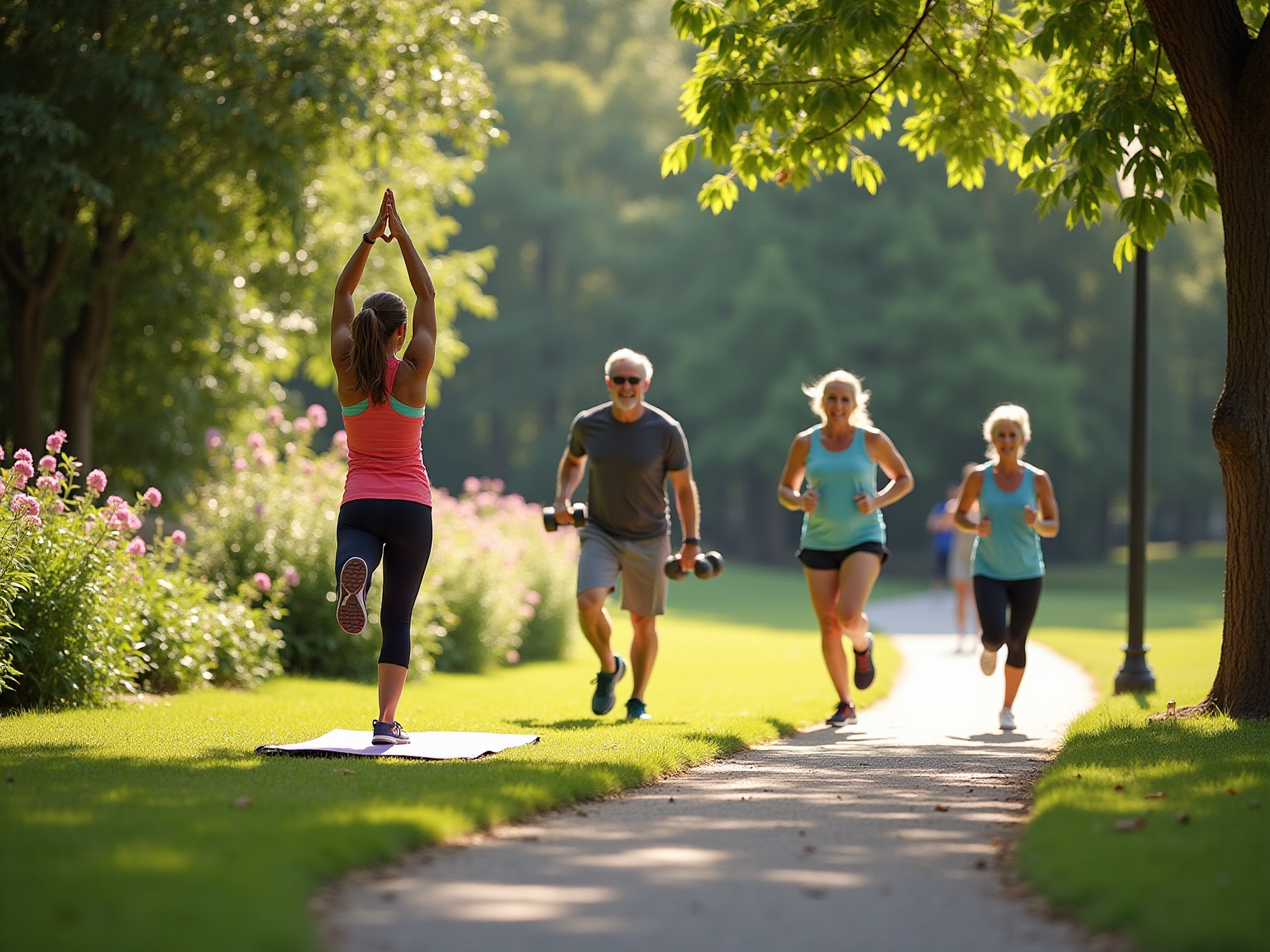5 Steps to Optimize Your Longevity Workout Routine
Overview
This article outlines five essential steps to optimize a longevity workout routine. It emphasizes the importance of:
- Cardiovascular exercise
- Strength training
- Flexibility
- High-intensity interval training
- Adequate recovery
Each component plays a crucial role in overall health, reducing the risk of chronic diseases, and enhancing physical performance. Ultimately, these practices promote a longer, healthier life.
What if you could improve your well-being simply by adjusting your workout routine? By incorporating these five elements, you can significantly impact your health and longevity. Consider how cardiovascular exercise boosts heart health, while strength training builds muscle and bone density. Flexibility enhances mobility, and high-intensity interval training maximizes calorie burn in shorter periods. Adequate recovery ensures your body heals and grows stronger.
In conclusion, adopting these practices not only enhances your physical performance but also contributes to a healthier, more vibrant life. Explore these strategies further to unlock your potential for longevity and well-being.
Introduction
In a world where the quest for longevity has become increasingly relevant, understanding the significance of longevity workouts can transform the health journey for enthusiasts and individuals alike. These workouts not only enhance physical fitness but also play a crucial role in extending lifespan and improving overall well-being.
Research continues to unveil the profound benefits of regular physical activity, from reduced risks of chronic diseases to enhanced mental health. Therefore, incorporating a balanced mix of cardiovascular, strength, and flexibility exercises is essential. This article explores the key components of a longevity-focused workout routine, offers practical scheduling tips, and highlights additional strategies to optimize health and recovery.
Together, these insights pave the way for a vibrant and active lifestyle.
Understand the Importance of Longevity Workouts
Longevity workouts are essential for enhancing overall well-being and extending lifespan. Regular physical exercise significantly lowers the risk of chronic diseases, boosts mental health, and helps preserve muscle mass as we age. Studies indicate that individuals who engage in consistent exercise experience a notable decrease in mortality rates; even moderate physical activity can contribute to a longer life.
For instance, a study published in JAMA Oncology found that small amounts of vigorous intermittent lifestyle exercise are associated with a reduced risk of cancer. Furthermore, any combination of medium to high levels of vigorous activity (75 to 300 minutes per week) and moderate physical activity (150 to 600 minutes per week) can yield nearly the maximum reduction in mortality, estimated at about 35% to 42%. Recognizing the significance of longevity workouts fosters a deeper appreciation for their role in sustaining vitality and promoting healthy aging.
To enhance well-being and longevity, it is beneficial to incorporate a balanced variety of cardiovascular, strength, and flexibility activities. Notably, limited research suggests that strength training may provide additional longevity benefits, with strength athletes exhibiting a slightly higher life expectancy compared to those engaged in regular physical activity.
In addition to exercise, integrating quality nutrition into your routine is essential. ByKomi.com emphasizes the importance of anti-aging nutrition, which can amplify your exercise efforts. Prioritizing nutrient-dense foods, particularly those rich in omega-3 fatty acids and antioxidants, can further boost your well-being and longevity. By combining effective longevity workouts with innovative nutritional strategies, you can significantly improve your health and extend your lifespan.
Identify Key Components of Your Routine
To create an effective longevity workout, focus on incorporating the following key components:
- Cardiovascular Exercise: Aim for at least 150 minutes of moderate-intensity aerobic engagement each week. Participating in pursuits like brisk walking, cycling, or swimming not only improves heart health but also increases overall endurance. Research indicates that small amounts of vigorous intermittent lifestyle physical activity are linked to a lower risk of cancer. Studies show that even brief bursts of activity can significantly reduce this risk, underscoring the importance of staying active.
- Strength Training: Incorporate strength training activities at least two days a week, focusing on major muscle groups. Using free weights, resistance bands, or bodyweight routines such as squats and push-ups can greatly enhance muscle mass and functional strength. These elements are essential for preserving independence as you grow older.
- Flexibility and Balance: Incorporate stretching and balance exercises to enhance mobility and reduce the risk of falls. Practices such as yoga and tai chi are particularly beneficial, promoting both flexibility and stability, which are essential for healthy aging.
- High-Intensity Interval Training (HIIT): Consider incorporating HIIT sessions into your routine to enhance cardiovascular fitness and metabolic well-being. This approach involves short bursts of intense activity followed by rest. It has been shown to be effective for longevity and overall fitness. A study analyzing high-intensity endurance activities discovered no detrimental impacts on cardiovascular well-being, reinforcing the safety of this training approach.
- Recovery: Ensure adequate recovery time between workouts to prevent injury and facilitate muscle repair. This can encompass planned rest days and active recovery sessions, such as gentle walking or stretching, which are essential for maintaining long-term fitness adherence and wellness advantages.
- Prioritize Sleep: Acknowledge that insufficient sleep detrimentally affects cognitive function, physical condition, and immune strength. It is also linked to harmful effects on brain function and emotional wellness. Quality sleep is essential for recovery and overall well-being, making it a critical component of any longevity-focused routine. By ensuring you obtain sufficient restorative sleep, you improve your capacity to excel during training sessions and promote your body’s wellness as you grow older.
By concentrating on these elements, you can create a thorough longevity workout regimen that fosters longevity and boosts your overall well-being, in line with effective physical activity protocols that encourage lasting vitality.
Create a Weekly Workout Schedule
To enhance your longevity workout regimen, it is crucial to establish a balanced weekly plan that incorporates various forms of physical activities. A well-rounded plan not only boosts physical fitness but also contributes to overall health as you age. Here’s a sample workout schedule designed for longevity:
- Monday: Strength training (upper body focus) – 45 minutes
- Tuesday: Cardiovascular exercise (brisk walking or cycling) – 30 minutes
- Wednesday: Strength training (lower body focus) – 45 minutes
- Thursday: Flexibility and balance (yoga or tai chi) – 30 minutes
- Friday: High-Intensity Interval Training (HIIT) – 20 minutes
- Saturday: Cardiovascular exercise (swimming or jogging) – 30 minutes
- Sunday: Active recovery (light walking or stretching) – 30 minutes
This schedule can be adjusted based on individual fitness levels, ensuring that intensity and duration are tailored to personal capabilities. Incorporating rest days is essential for recovery, allowing the body to heal and adapt. Research indicates that increasing moderate-to-vigorous exercise can significantly decrease mortality rates among adults aged 40 and older. Even minor boosts in daily engagement can lead to a reduced risk of early death, emphasizing the significance of consistent movement. For individuals aged 60 and above, studies suggest that the risk of early death stabilizes at approximately 6,000 to 8,000 steps daily, underscoring the importance of regular physical exertion. As highlighted by the CDC’s Active People, Healthy Nation initiative, promoting greater physical engagement is vital for enhancing wellness and well-being across all age groups. This initiative supports the notion that regular exercise aids daily living activities and independence for people with disabilities. By adhering to a structured exercise plan, individuals can enhance their physical health and support their longevity goals, ultimately fostering a more vibrant and active lifestyle.
Monitor Progress and Adjust Your Routine
To ensure your longevity workout is effective, it is crucial to regularly monitor your progress. Here are some strategies to consider:
- Keep a Workout Journal: Record your exercises, sets, reps, and weights to track improvements over time. This practice not only provides a clear overview of your journey but also motivates you to stay committed.
- Set SMART Goals: Establish Specific, Measurable, Achievable, Relevant, and Time-bound goals to guide your progress. By doing so, you create a roadmap that helps you focus on what truly matters.
- Use Fitness Apps: Consider utilizing fitness tracking applications to record exercises and monitor metrics like heart rate and calories burned. These tools can provide valuable insights into your performance and help you stay on track.
- Assess Your Performance: Every few weeks, evaluate your performance by testing your strength, endurance, and flexibility. Adjust your routine based on these assessments to ensure continuous improvement. This reflective practice will help you identify areas for growth.
- Listen to Your Body: Pay attention to how your body reacts to exercise. If you feel fatigued or experience pain, it may be time to modify your routine or incorporate more recovery time. Being attuned to your body’s signals is essential for long-term success, and by implementing these strategies, you can effectively monitor your progress and enhance your exercise routine as part of your longevity workout.
![]()
Explore Additional Tips for Longevity and Recovery
In addition to your longevity workout, consider these tips to further enhance your longevity and recovery:
- Nutrition: Focus on a nutrient-dense diet rich in quality animal-based foods, healthy fats, and plenty of vegetables. Adequate nutrition aids muscle recovery and general well-being. Additionally, consider incorporating TMG into your regimen, as it works synergistically with NMN to ensure optimal cellular function by supplying methyl groups that NMN depletes.
- Hydration: Stay well-hydrated to optimize performance and recovery. Aim for at least 8-10 glasses of water daily, adjusting based on your activity level.
- Sleep: Prioritize quality sleep, aiming for 7-9 hours per night. Rest is vital for recovery and general well-being. Establishing a consistent sleep routine can significantly improve your sleep quality, making it easier to fall asleep and stay asleep. Many individuals, including myself, struggle to achieve the recommended hours due to busy schedules. However, experimenting with different sleep strategies can be beneficial, as shared by others in the community.
- Stress Management: Incorporate stress-reducing practices such as meditation, deep breathing, or spending time in nature to support mental well-being and recovery.
- Regular Check-ups: Schedule regular health check-ups to monitor your overall health and make informed decisions about your fitness and wellness journey.
Conclusion
Incorporating longevity workouts into daily routines is essential for enhancing health and extending lifespan. These workouts encompass a balanced mix of cardiovascular, strength, and flexibility exercises, each contributing significantly to reducing the risk of chronic diseases and promoting overall well-being. Regular physical activity not only fosters physical health but also supports mental clarity and emotional resilience, making it a cornerstone of a vibrant lifestyle.
Creating a structured workout schedule further amplifies the benefits of longevity workouts. By thoughtfully integrating various exercise types throughout the week, individuals can tailor their routines to meet personal fitness levels while ensuring adequate recovery. This approach not only enhances physical capabilities but also reinforces the commitment to a long-term health journey. Monitoring progress, setting specific goals, and adjusting routines as necessary are crucial steps in maintaining motivation and ensuring continued improvement.
Furthermore, optimizing overall health goes beyond exercise alone. Emphasizing quality nutrition, proper hydration, sufficient sleep, and effective stress management creates a holistic approach to longevity. Regular health check-ups and mindful practices can further support the body’s recovery processes and enhance longevity outcomes.
Ultimately, embracing a longevity-focused lifestyle, characterized by consistent physical activity and mindful health practices, empowers individuals to lead fulfilling lives while minimizing the risks associated with aging. The path to a longer, healthier life is within reach, and it begins with the commitment to prioritize longevity workouts and comprehensive wellness strategies.
Frequently Asked Questions
What are longevity workouts and why are they important?
Longevity workouts are essential for enhancing overall well-being and extending lifespan. They significantly lower the risk of chronic diseases, boost mental health, and help preserve muscle mass as we age.
How does regular exercise affect mortality rates?
Studies indicate that individuals who engage in consistent exercise experience a notable decrease in mortality rates. Even moderate physical activity can contribute to a longer life.
What types of physical activity are recommended for longevity?
A balanced variety of cardiovascular, strength, and flexibility activities is beneficial for enhancing well-being and longevity.
What is the recommended amount of cardiovascular exercise for longevity?
It is recommended to aim for at least 150 minutes of moderate-intensity aerobic exercise each week.
How does strength training contribute to longevity?
Incorporating strength training at least two days a week can enhance muscle mass and functional strength, which are essential for preserving independence as we age.
What role do flexibility and balance exercises play in longevity workouts?
Flexibility and balance exercises, such as yoga and tai chi, enhance mobility and reduce the risk of falls, which are essential for healthy aging.
What is High-Intensity Interval Training (HIIT) and its benefits?
HIIT involves short bursts of intense activity followed by rest and can enhance cardiovascular fitness and metabolic well-being, contributing to longevity and overall fitness.
Why is recovery important in a longevity workout routine?
Adequate recovery time between workouts prevents injury and facilitates muscle repair, which is essential for maintaining long-term fitness adherence and wellness.
How does sleep affect overall well-being in the context of longevity?
Quality sleep is critical for recovery and overall well-being, as insufficient sleep negatively impacts cognitive function, physical condition, and immune strength.
What nutritional strategies can complement longevity workouts?
Integrating quality nutrition, particularly focusing on nutrient-dense foods rich in omega-3 fatty acids and antioxidants, can amplify the benefits of exercise and improve overall health and longevity.






